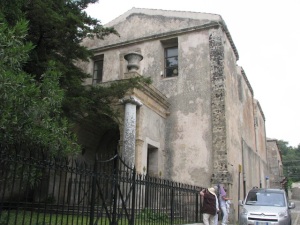A few days ago, I wrote briefly about the Sicilian town of Trapani, which is where our ship first docked on the island. On a mountain almost 2500 feet above that city lies the medieval fortress town of Erice, a beautiful site with a long and interesting history.
Erice, called Eryx by the Greeks and Romans, was founded by the Elymians, a somewhat mysterious pre-Greek people who inhabited western Sicily. It is possible that they were from Anatolia, and that there is some truth to the legend that Trapani was founded by Trojans fleeing the destruction of their city, although it is also just as possible that they were migrants from Anatolia who left that area for more benign reasons than the Trojan War. In any case, by the 5th century B.C., the town was for all intents and purposes dependent on nearby Segesta (see my earlier blog post on that beautiful site). Like many of the important cities in this area, Eryx was eventually taken by the Carthaginians, and their Phoenician language appears on coins of the city from the fourth century B.C. The surviving sections of defensive walls from this early period also show the marks of Phoenician masons.
It was the Phoenicians who established the worship of the goddess Astarte and built a temple in her honor on the slopes of the mountain above Trapani. The rites of Astarte, a goddess of fertility, included the practice of sacred prostitution. The temple and its prostitutes were understandably popular with sailors who made port at Trapani. Although the steep climb of 2500 feet must have been somewhat daunting, the payoff seems to have been worth it – the cult retained its popularity through the later Greek and Roman centuries. Depending on the culture in power on Sicily at various times, the patron goddess of the cult was known as Astarte, Aphrodite (by the Greeks), or Venus (by the Romans), all names for the same powerful deity of feminine regenerative fertility. In fact, it is very likely that the worship of such a fertility goddess pre-dated even the Phoenicians, although they are the ones who seem to have institutionalized the celebration of her cult. The temple of Astarte-Aphrodite-Venus guaranteed the popularity of Eryx in antiquity. Unfortunately, it is now completely overbuilt by a 12th-century Norman castle known, appropriately, as the Castello di Venere.
Venus’s presence also lent credence to the Roman claim that the city was founded by the Trojans, because their leader Aeneas was believed to have been descended from that goddess. In the Aeneid, Virgil includes a scene in which Aeneas arrives at the site of Eryx and founds the temple in her honor (Aen. 5.759 ff.). So taken were the Romans with this popular goddess (known to them as Venus Erycina) that they exported her worship throughout the empire and built temples for her even at Rome.
As I mentioned, her temple is unfortunately not visible at modern Erice. What IS to be found there, however, is a gorgeous medieval walled town. A very curvy and slightly harrowing bus ride, made all the more nail-bitingly nerve-wracking by the thick fog that had settled over the coast, took us up to the town (it is also possible to ride up by cable car).
As with many medieval towns that are now tourist attractions, Erice hosts plenty of souvenir shops but still manages to retain much of its charm in its winding, narrow streets. Some of the shops even boast an impressive pedigree, continuing the tradition of baked goods produced for centuries at some of the religious institutions in the town. The “Old Confectioners of the Convent” (Antica Pasticceria del Convento), for example, is well worth a visit, and is frequently cited as one of the best pastry shops in all of Sicily.

"Bellibrutti" (unsightly beauty), a popular traditional pastry at the Antica Pasticceria del Convento
It was founded by Maria Grammatico, an orphan who learned to cook in the kitchens of one of Erice’s several convents in the 1950s. Her story is recounted in the book Bitter Almonds, complete with traditional recipes.
An important monument is the Chiesa Matrice, the 14th-century cathedral, which has elements of both the Romanesque and Gothic styles.
The church is dedicated to the Virgin of the Assumption. This dedication was not made lightly: highlighting the virginity of Mary made a powerful statement about her triumph over the fertility cult for which ancient Eryx had been famous.
Additionally, the feast of the Virgin of the Assumption is celebrated in August (on the 15th), which was also the month in which the most important festival of Astarte-Aphrodite-Venus fell. In a new Christian world, Mary the Virgin had replaced the prostitutes of Venus.
In addition to its importance as a historical site, Erice also draws crowds of a different and somewhat unexpected sort. Since 1963, the town has played host to the Ettore Majorana Foundation and Centre for Scientific Culture (Ettore Majorana was an important Sicilian physicist). Every summer, scientists flock to Erice to discuss advances in cutting-edge research. The theme for 2011 was “The Second Workshop on Hadron Beam Therapy of Cancer”; in 2010 it was “Advances in Nanophotonics III: Plasmonics and Energy Efficiency.” The classes and seminars are hosted in historic buildings that once served religious and civic functions, such as the San Francesco monastery.

San Francesco Monastery, now home to the Eugene P. Wigner Institute with the Enrico Fermi Lecture Hall
It is quite fascinating that this tiny city, with a heritage reaching back into the first millenium B.C., now plays host to some of the world’s foremost scientific minds and witnesses the discovery and dissemination of advanced scientific theories. Whether a traveler is interested in the ancient history of Sicily, in culinary traditions, or in the important work of modern men and women of science, Erice has something for everyone.




